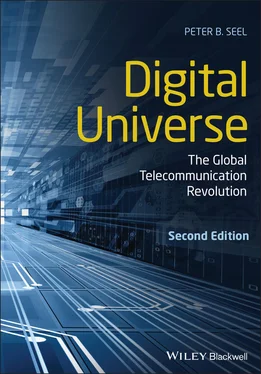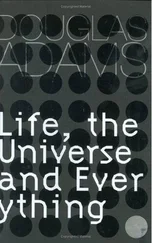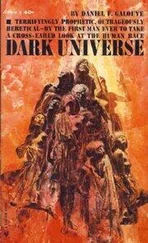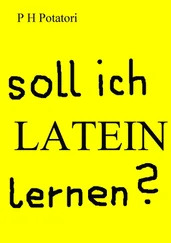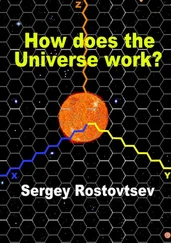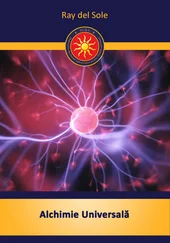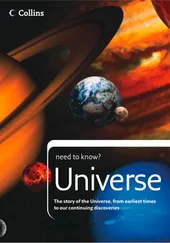This book is about the global use of digital technologies and their effects on society. Some of these effects are beneficial in enhancing human communication and understanding. Others are less benign as they encourage increasingly sedentary lifestyles, the loss of personal privacy, and technological dependence. The stories of how information and communication technologies evolved to those that we use daily is a fascinating one and form a significant part of this book. The contemplation of the future of these technologies as we augment our personal and collective intelligence is a compelling topic that we will examine in these chapters. My hope is that the exploration of these themes will encourage you to think critically about the digital technologies that you use every day and how they might enhance or detract from human life in the future.
First and foremost, I extend my appreciation to my life partner Kay Collins for her insightful feedback about the revisions in the second edition. Her professional background as an intellectual property attorney was very helpful in understanding how digital technology has affected every profession and how AI might affect information-focused professions in the future.
I would like to thank my managing editor at Wiley-Blackwell, Andrew Minton, for his support during the year of research and writing for this edition. We were all working from home during the COVID-quarantine year of 2020, and Andrew and his executive editor Todd Green followed the progress of revising the manuscript with interest and encouragement. Special thanks to associate editor Nicole Allen and editorial assistant Sophie Bradwell at Wiley’s offices in Chichester in the United Kingdom for their fine work on preparing the manuscript for publication. I am greatly indebted to Carol Thomas for her thorough and detailed work copy-editing the text for each chapter and double-checking the links in the citations. Johannah Racz Knudson again provided a thorough and detailed index for the second edition.
A special note of appreciation goes to my colleague, Jaye Powers, who has taught online versions of our New Communication Technologies and Society course for the past decade. Each semester, Professor Powers asked her students to provide constructive written feedback on the first edition of this book, which I have incorporated in this new edition. This student-focused feedback was especially insightful in revising and updating this text.
I would like to thank my former students and colleagues in the Department of Journalism and Media Communication at Colorado State University for their support while I was a professor working my way up through the ranks. I retired in January of 2020, but have maintained my contacts with my friends among the faculty, chair Greg Luft, staff, and many graduates of our BS, MS, and MCMM programs over two decades of teaching and conducting research in communication technology. Specifically, I want to extend my appreciation to colleague Mike Humphrey and CSU social media expert Ashleigh Schroeder for their contributions to the key terms list.
Thanks to my faculty colleague Tim Amidon at CSU for the introduction to the insightful scholars Safiya Umoja Noble at UCLA and Shoshana Zuboff at Harvard. Their critical perspectives were included in the chapters on search technologies and privacy issues related to digital surveillance.
My son, Peter James Seel, contributed helpful feedback for the chapter on Alternative Digital Realities about digital game culture and e-sports, an area of personal expertise. Friend Michael Szczepaniak is a professional working in information technology and contributed to the chapter on artificial intelligence and machine learning with many helpful comments. Retired telephone company executive Clifton Phalen shared unique insights about working for one of the regional Bell operating companies when it was part of AT&T.
Continued thanks to the key individuals who provided guidance and valuable feedback in the first edition of this book. It would not have been written without the support of Elizabeth Swayze, my first editor at Wiley-Blackwell. She believed in the importance of the topic and provided ongoing encouragement through multiple drafts. Helpful comments about the content of the book were provided by my longtime friend and co-author on previous book projects, August E. “Augie” Grant, of the University of South Carolina. Amy Reitz and Carol Anderson Reinhardt assisted in editing early chapters and their input is gratefully appreciated. Don Zimmerman of Colorado State University was helpful in providing support from the Center for Research in Writing and Communication Technologies. I would also like to thank the graduate students enrolled in my telecommunication technology seminars for their insightful comments on the book’s first edition.
Assistance in locating photographs for inclusion in the book were provided by Marianne Heilig for her father’s photos, George Despres at MITRE, Lauren Skrabala at RAND, Angela Alvaro at Banco de Espana in Madrid, Leonard Kleinrock at UCLA, Dina Basin at SRI, Mekialaya White at KCNC-TV in Denver, Christine Engelbart and Mary Coppernoll at the Doug Engelbart Institute, Jayne Burke at NYU, Jan Walker at DARPA, Eric Mankin and Claude Zachary at USC, Sophie Tesauri at CERN, and by photographers Patrick Troud-Chastenet, Irene Fertik, and Gary MacFadden. Many images were provided by photographers via the Creative Commons, and this has become a helpful resource for authors and educators worldwide.
Part I Introduction and Framing
1 Immersion in the Digital Universe
In the August 2005 issue of Wired magazine, then-editor Kevin Kelly published an essay titled “We are the Web” that was widely read by its digitally savvy audience. 1In the essay, he made a number of predictions about what he termed “Web 2.0,” the second major iteration of the World Wide Web, which was then underway. He observed that the Web was an emergent technology before the Initial Public Offering (IPO) of Netscape in 1995, but cited Eric Schmidt (then Chief Executive Officer (CEO) at Sun Microsystems and later at Apple and Google) as noting that the day before the IPO the Web was nothing and afterward it was everything.
Kelly predicted that, with the rapid evolution of the Web at the time, “We would come to live inside this thing.” 2Recall that he made this prediction two years before the advent of the iPhone in 2007. I think he would be astonished to look back at present and realize how prescient he was with this insight. In fact, the term “immersion” is now widely used to describe experiencing a digitally created environment in such a profound manner that users are transported by their senses into that digital universe.
The rapid evolution of the mobile phone into a “smart” phone occurred during the transition from 3G to 4G wireless technologies in the decade between 2009 and 2019. 3I would argue that this transition marked a watershed in digital immersion in that users could download hundreds of new apps that transformed the phone into a portable computer capable of doing almost everything a laptop could do at that time. This key transition, and the evolution to 5G technologies, are addressed in greater detail in Chapter 8on mobile telephony. However, most mobile device users today take for granted the remarkable number of services provided by their phones. In fact, the first thing that connected users do on arising is check their mobile devices – and heaven forbid that they have forgotten to recharge the battery overnight. Our smart phones often recharge on a bedside table next to a smart speaker that can provide the day’s weather forecast or the news headlines with a simple audible request to Alexa, Siri, or Google for more information. We do “live inside this thing,” as Kevin Kelly stated in 2005, and in ways that even the most ardent technophiles could not have predicted then.
Читать дальше
